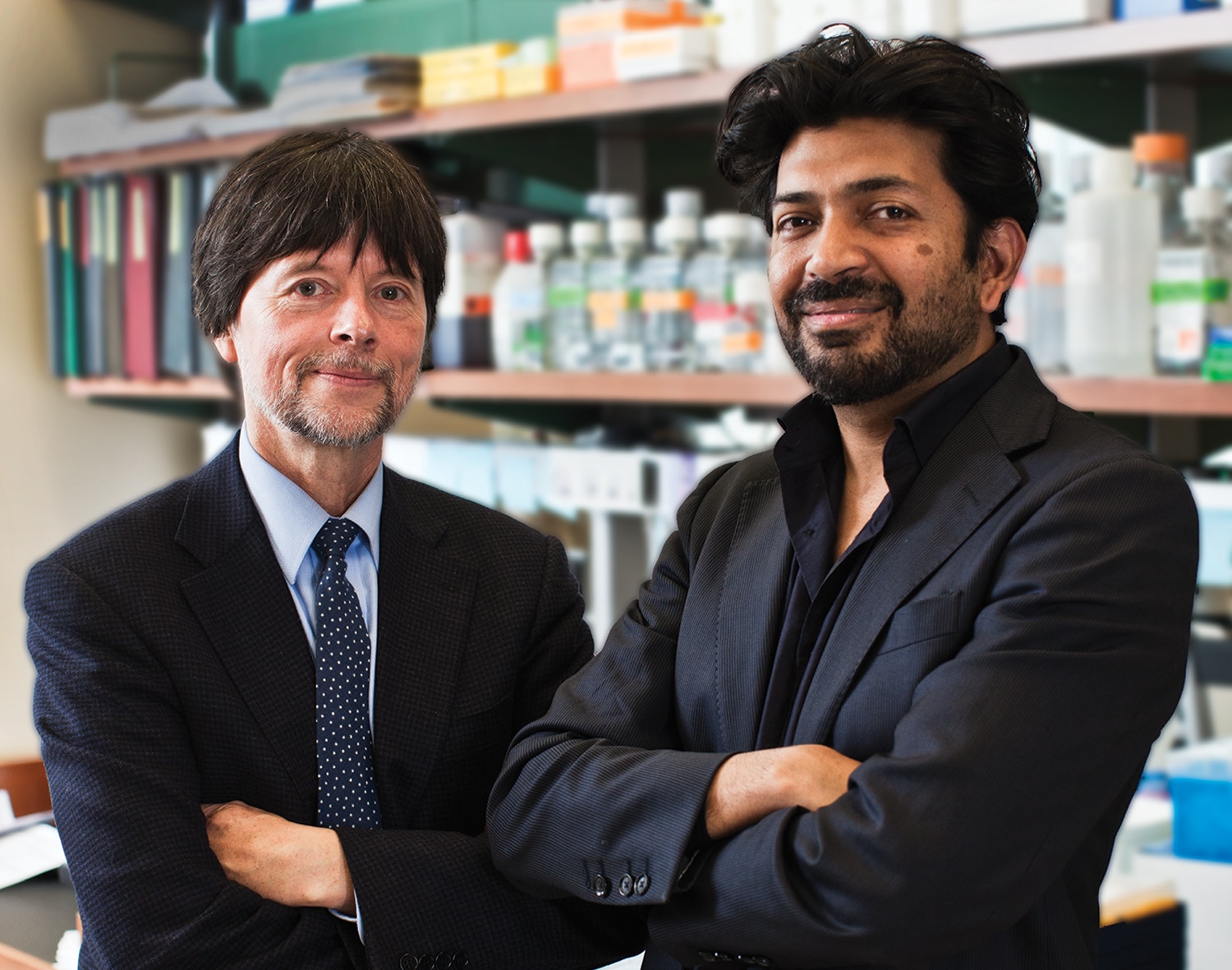WHEN SIDDHARTHA MUKHERJEE was an oncology fellow at the Dana-Farber Cancer Institute and Massachusetts General Hospital in Boston, he was sometimes unable to answer questions that patients asked about the origins of cancer, how treatments had evolved, and progress in developing new therapies. He looked for a book to guide him, but he couldn’t find one. “I was astonished by this,” says Mukherjee, who is now an assistant professor of medicine at Columbia University in New York City. “Here we were, 4,000 years in one of the most complex, long-standing human projects in history, and we didn’t have a roadmap to where we had come from, where we were going, why we were here, and what was happening next.” Mukherjee decided to write a book to answer these important questions and devoted several years to the project.
The book, The Emperor of All Maladies: A Biography of Cancer, was published in 2010. It describes the history of cancer by focusing on pioneers who developed surgical procedures and experimented with chemotherapy, as well as scientists who revealed the mechanisms underlying the unchecked growth of cancer cells. Woven through the narrative are stories of activists who raised public awareness of cancer and patients who benefited from treatment advances. In 2011, Mukherjee’s book won the Pulitzer Prize for general nonfiction.
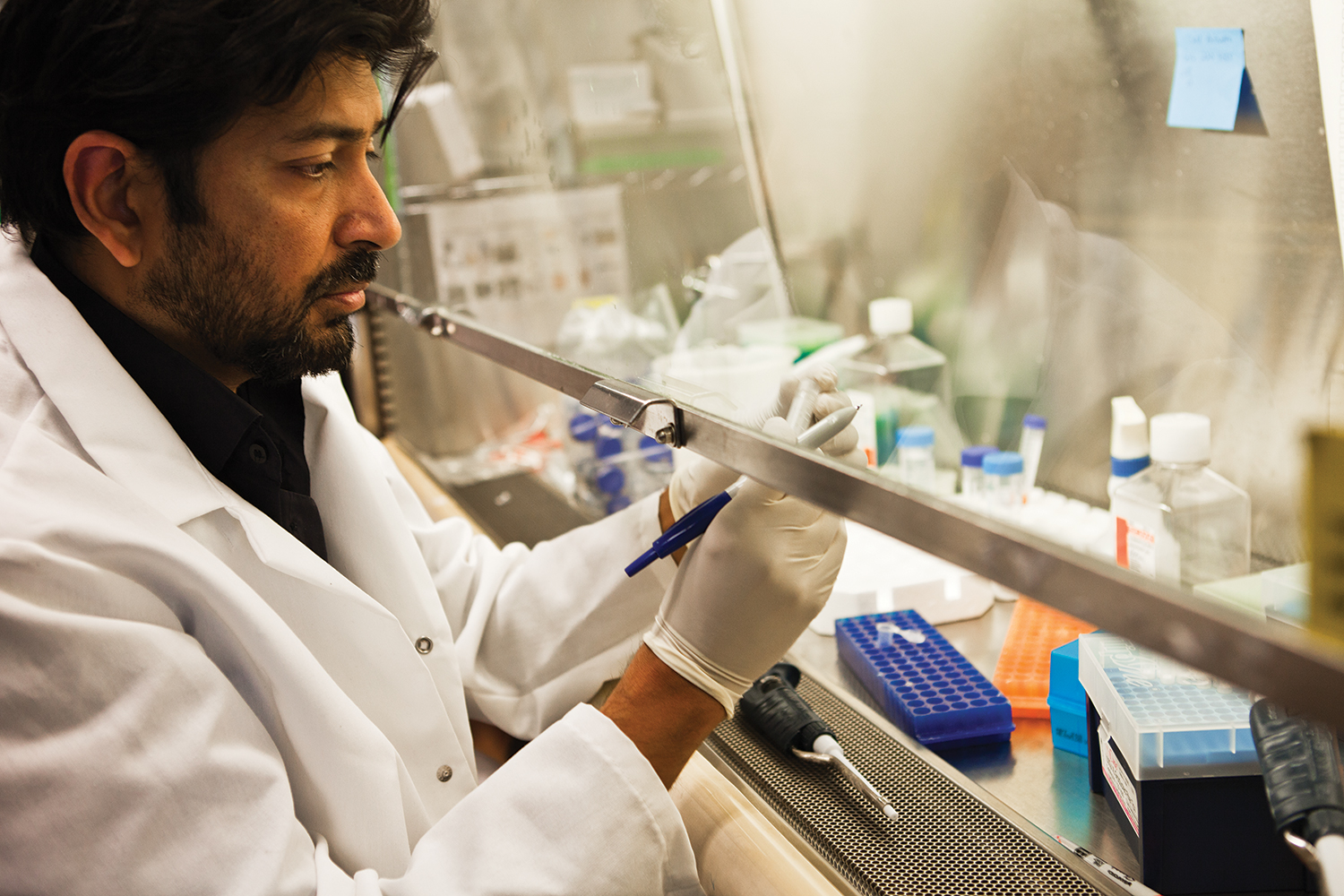
Researcher and oncologist Siddhartha Mukherjee works in his laboratory in the Irving Cancer Research Center at Columbia University Medical Center in New York City. Photo by Michael Weschler
Laying the Groundwork for a Documentary
Nearly five years after the book was published, a six-hour documentary based on it will air on television stations in the Public Broadcasting Service (PBS) network in spring 2015. Titled Ken Burns Presents “Cancer: The Emperor of All Maladies” A Film by Barak Goodman, the documentary will run in two-hour segments from March 30 to April 1. Filmmaker Ken Burns—who served as executive producer, co-writer and senior creative consultant—describes the film as a way to learn about “the enemy, and because the enemy is within us, it makes [for] a much more fascinating story … one we ought to have the courage to look at and understand, because there is no one, no one who remains untouched by cancer in their lifetime.”
Cancer: The Emperor of All Maladies came to fruition due to the passion and perseverance of two powerful women in the media: Sharon Percy Rockefeller, the president and CEO of WETA, the PBS station in Washington, D.C., and Laura Ziskin, the founder and former president of Laura Ziskin Pictures and a co-founder of Stand Up To Cancer. Both women had been diagnosed with cancer—Rockefeller in 2005 with stage IIIB colorectal cancer and Ziskin in 2004 with metastatic breast cancer—and both were eager to make a documentary about the disease. In Mukherjee’s book, they found their source material.
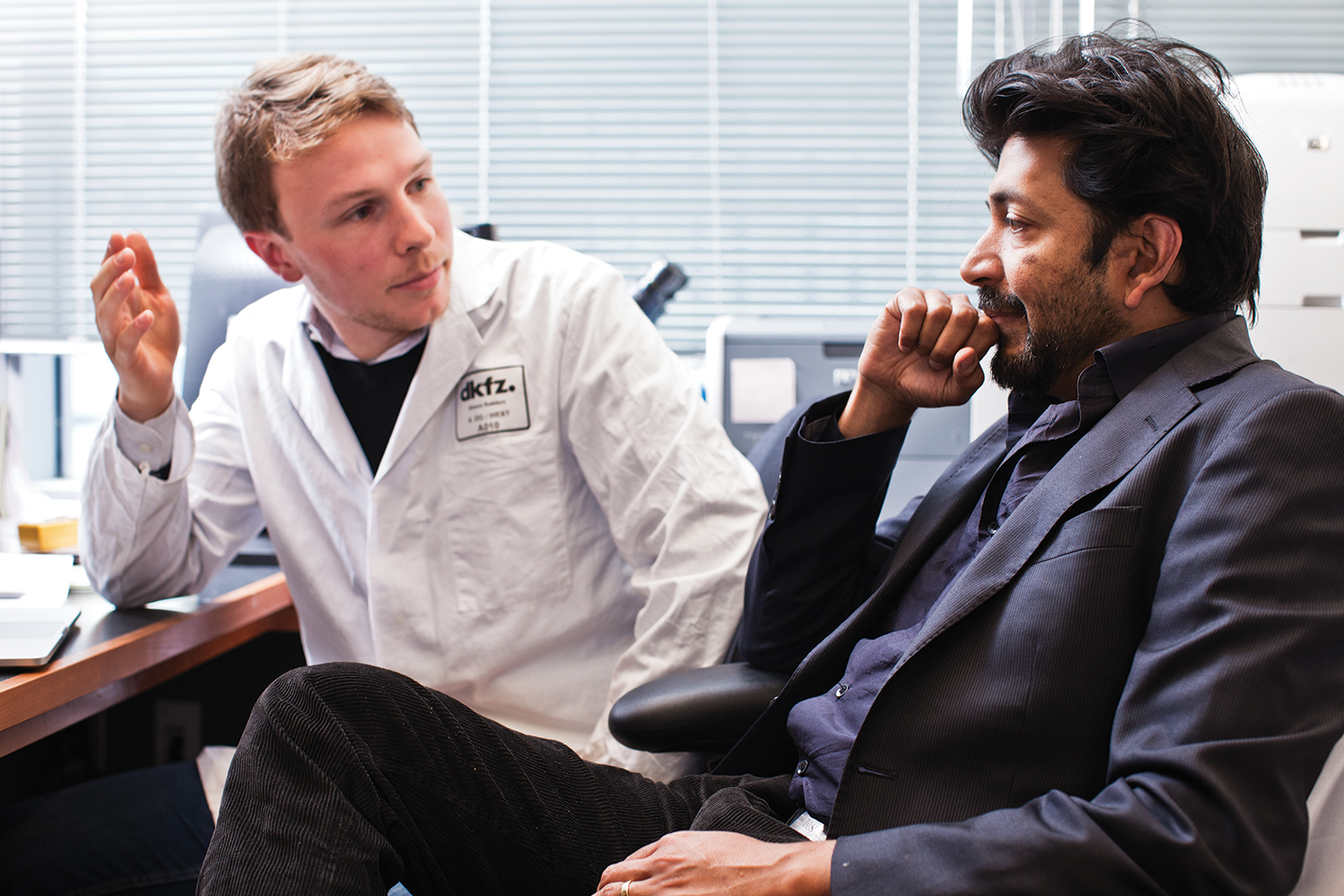
Siddhartha Mukherjee consults with researcher Simon Renders in Mukherjee’s laboratory in the Irving Cancer Research Center at Columbia University Medical Center in New York City. Photo by Michael Weschler
“The book had everything,” says Rockefeller. “It was beautifully written and wasn’t overly scientific. It has a focus on patients, so you can get the human stories. But even better, it starts with the history. That gives the context. You think, ‘I’m not alone in this.’ ”
For her own cancer, Rockefeller endured grueling treatments—an eight-week regimen of chemotherapy given at the same time as daily radiation treatments—and survived. Ziskin was not as fortunate—she died in June 2011. Pam Williams, now president of Laura Ziskin Pictures, remembers that Ziskin’s dream was to make a film that would create a tipping point for cancer research, as An Inconvenient Truth had done for global warming. She says Ziskin wanted to jump-start the conversation and make sure that “people understand that we must make it a priority to conquer this disease.”
The legendary documentary filmmaker lost his mother to breast cancer when he was 11 years old.
For Ken Burns, executive producer, co-writer and senior creative consultant for Cancer: The Emperor of All Maladies, involvement in the film has been deeply personal. In 1955, when he was 2, his mother, Lyla, was diagnosed with breast cancer. She was only 32 years old. When Burns was 7, “my parents sat me and my younger brother down to tell us she had terminal cancer, that she wasn’t expected to live more than six months. The extraordinary thing is that she lived almost five years more. We had the great privilege of watching her heroically struggle with the disease.” Lyla Burns lived for nearly 10 years after her initial diagnosis, longer than most women diagnosed in that era.

Lyla Burns feeds her infant son, Ken Burns, in 1954. Lyla was diagnosed with breast cancer in 1955 and died nearly 10 years later, when Burns was 11. Photo by Robert Burns, © National Geographic
Her illness took a toll on the family. Burns remembers a time in the late 1950s when a hospital bed was brought into their Newark, Delaware, home, and the living room was converted into his mother’s bedroom. She also spent long periods in the hospital. Burns recalls that his mother underwent a radical mastectomy when she was first diagnosed. Typically a surgeon performed a radical mastectomy by removing not only the breast, but the underarm lymph nodes and chest wall muscles. In 1962, doctors removed Lyla’s pituitary gland, thinking hormones produced by the pituitary might be stimulating cancer growth. The treatment was not effective, and her cancer continued to advance.
Lyla died on April 28, 1965, at the age of 42. Burns was 11 years old. “My brother and I still refer to her as Mommy because that’s how she left when we were young boys,” reflects Burns. “You know, it’s sort of funny, but unabashedly, she’s Mommy.”
Burns says his mother’s death helped make him the person he is today. Soon after her death and after seeing his father, Robert, cry for the first time while watching a movie, he decided he wanted to make films. “I wanted to allow complicated emotions … to come to the surface. I could do that by telling stories from the past and present. There is an equal amount of drama in what is and what was, the present and the past, as in anything the human imagination makes up.”
Laying the Groundwork for a Documentary
Since Lyla’s death in 1965, breast cancer outcomes have improved greatly. In the early 1960s, 63 percent of women diagnosed with breast cancer survived five years or longer. Today 89 percent of women diagnosed with the disease survive at least five years, although only 24 percent of women with metastatic breast cancer survive at least that long.
“We now know that breast cancer is several different kinds of cancer, possibly as many as six to eight subtypes, and we know how to treat many of those,” says oncologist Powel H. Brown, chairman of the Department of Clinical Cancer Prevention at the University of Texas M. D. Anderson Cancer Center in Houston. The most common variety of invasive breast cancer is hormone-receptor-positive cancer, so called because its growth is driven by estrogen or progesterone. Two of three women with invasive breast cancer have this type. According to Brown, one of the most important discoveries in breast cancer treatment has been tamoxifen, which blocks estrogen’s effects in the breast.
HER2-positive breast cancer, fueled by overproduction of the HER2 protein, affects about 20 to 30 percent of patients overall. Those diagnosed with this type of breast cancer once faced a grim prognosis. Things began to change in 1998, when the FDA approved the addition of Herceptin (trastuzumab) to chemotherapy for the treatment of women with late-stage HER2-positive disease. Herceptin works by attaching to cells that overproduce the HER2 protein and bringing in immune cells to kill them. There are now three other HER2-targeted therapies: Perjeta (pertuzumab), Tykerb (lapatinib) and Kadcycla (T-DM1). Kadcycla combines Herceptin with chemotherapy.
Triple-negative breast cancer, accounting for 10 to 20 percent of breast cancer cases, remains difficult to treat, largely because there is no known target for treatment, such as estrogen or HER2, and it can be more aggressive. New research, however, is leading to new developments. “We now know that triple-negative breast cancer can be divided into at least four and as many as seven groups,” explains Brown. “Some triple-negative breast cancers have an androgen or testosterone receptor, so testosterone-blocking drugs are being tested in clinical trials to treat this subtype of triple-negative disease.”
Although much work needs to be done, “the pace of research is exponential,” says Brown. “A combination of new and tried-and-true treatments has greatly improved treatment and survival for women with breast cancer.”
Ziskin’s team had already obtained the rights to make a film based on the book and was in discussions with HBO in early 2011 when Rockefeller and Dalton Delan, WETA’s chief programming officer, approached Mukherjee about producing a documentary. Mukherjee explained his earlier commitment to Ziskin, but it was clear he understood the potential reach of public television, Rockefeller says.
That’s when Mukherjee asked if Ken Burns was available to make the film. “I said, ‘Oh no, we’ve worked with Ken for 25 years, but he comes up with all of his own ideas,’ ” Rockefeller says. “ ‘He is an artist. The ideas are his. The projects are his. The films are his.’ ” And Burns had commitments through the next decade, she added. But Mukherjee persisted, so Rockefeller arranged a meeting between the men that turned into a three-and-a-half-hour lunch. “I just let them be, two geniuses together, sizing each other up and really enjoying each other’s company and minds,” Rockefeller recalls. Mukherjee adds: “We talked about … how it would have to be about history, but also about the future. … We talked about those kinds of very big schematic questions.”
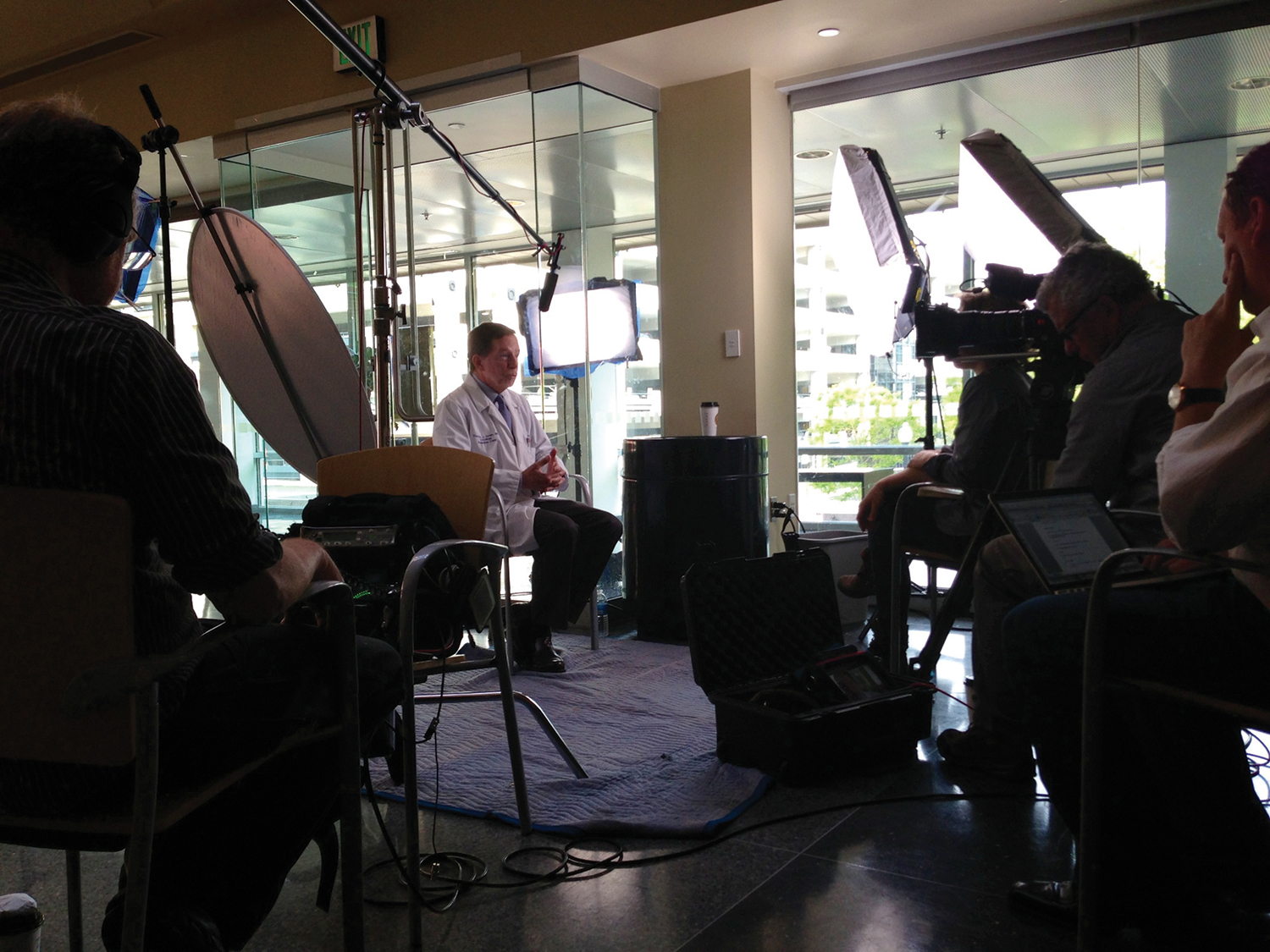
Cancer: The Emperor of All Maladies was shot in a number of locations. Here, oncologist Thomas Smith, the director of Palliative Care at Johns Hopkins in Baltimore, is interviewed. Photo by Michael Weschler
Mukherjee told Ziskin and Williams about his conversation with the man he calls “the pre-eminent documentarian of our generation.” Williams flew to San Francisco to meet with Burns, and Ziskin joined them on Skype for what Williams calls a “meeting-of-the-minds conversation about what this could be and what Laura’s passion for it was, what Ken’s passion for it was. We knew that there was nobody else we wanted involved but Ken and WETA to partner with.”
The result of these conversations was a working relationship among Burns’ Florentine Films, Laura Ziskin Pictures and WETA, in collaboration with Ark Media. The latter was brought in when Burns asked that day-to-day production be handled by another producer and director. Barak Goodman of Ark Media was selected to fill the role. Goodman’s 2000 film Scottsboro: An American Tragedy had been nominated for an Oscar.
The American Association for Cancer Research supports the film and fosters scientific collaboration.
The American Association for Cancer Research (AACR), publisher of Cancer Today, is a supporter of Cancer: The Emperor of All Maladies. Since 1907, when 11 laboratory and clinical researchers founded the AACR “to further the investigation and spread the knowledge of cancer,” the association has been at the center of cancer research. Today, the AACR has more than 33,000 members in 101 countries, among them 39 Nobel laureates. Fifty-eight Nobel laureates in total have been AACR members.
“The history of the AACR is the history of cancer research,” says Margaret Foti, PhD, MD (hc), chief executive officer. “It is the first organization formed to address the cancer problem.
“Since the inception of the AACR, its members have been at the forefront of advances to benefit cancer patients,” she adds. “The major contributors to progress in the cancer field have been or are AACR members.”
Foti notes that the AACR honors scientists whose contributions have propelled significant innovation and progress against cancer by naming them Fellows of the AACR Academy. There are 144 fellows to date.
To fulfill its mission to prevent and cure cancer though research, education, communication and collaboration, the AACR publishes eight peer-reviewed journals, Cancer Today and the annual AACR Cancer Progress Report. The association funds cancer research directly and through other organizations, including its role as the scientific partner for Stand Up To Cancer, providing expert peer review, grants administration and scientific oversight of team science projects in addition to innovative research conducted by young investigators.
The AACR communicates with legislators and policymakers about the value of cancer research and, more broadly, biomedical research, and hosts more than 20 scientific conferences and education workshops annually.
The AACR also reaches out to help those whose lives have been affected by cancer through the Survivor and Patient Advocacy program. The AACR Foundation provides financial support for scientific research, education and communication.
Foti targets three challenges that need to be addressed if progress against cancer is to continue.
“One key is a sustained increase in funding for cancer research,” she says, especially federal funding. The AACR joins other national organizations annually for a Rally for Medical Research Capitol Hill Day in Washington, D.C. In 2014, participants from more than 300 organizations called on policymakers to make federal funding for medical research a national priority.
A second and related challenge is to find ways to keep talented young scientists working in cancer and biomedical research. Lack of funding often leads them to enter other fields.
“We will lose a whole generation of scientists whose work could have made a difference,” she says, if a solution isn’t found to the brain drain.
A third challenge is to foster collaboration among scientists through multi-institutional, cross-disciplinary research teams. “We need to maximize collaboration across key disciplines and to encourage team science and translational research,” she says.
Foti believes Cancer: The Emperor of All Maladies will raise public awareness of the urgency of addressing the cancer problem. “I’m confident that the airing of this film will put the topic of cancer in the forefront of people’s minds and create a national dialogue about cancer and the vital importance of cancer research,” she says.
From Book to Film: The Creative Process
The team decided to use the same structure for the documentary as Mukherjee had used for the book. The “past” segment would focus on cancer’s history, with spotlights placed on pioneering oncologist and cancer researcher Sidney Farber of Children’s Hospital in Boston and philanthropist and cancer research activist Mary Lasker, who played an important role in shaping the American Cancer Society. In his book, Mukherjee had used these two early figures to illustrate how Farber’s experiments with chemotherapy in the late 1940s and Lasker’s connections, energy and passion had ignited the “War on Cancer,” which began to gain momentum in the 1950s.
Similar to Ken Burns’ earlier films, the historical segment uses archival photographs and film footage. Mukherjee, who appears throughout the film, interviews Elliott Sandler, the twin brother of Robert Sandler. In December 1947, at the age of 2, Robert was the first of Farber’s leukemia patients to go into remission after being treated with a chemical called aminopterin. Robert’s relief from leukemia was short-lived—he died in April 1949, 15 months after receiving the treatment. Mukherjee was so moved by Robert’s story that he dedicated his book to Farber’s young patient.
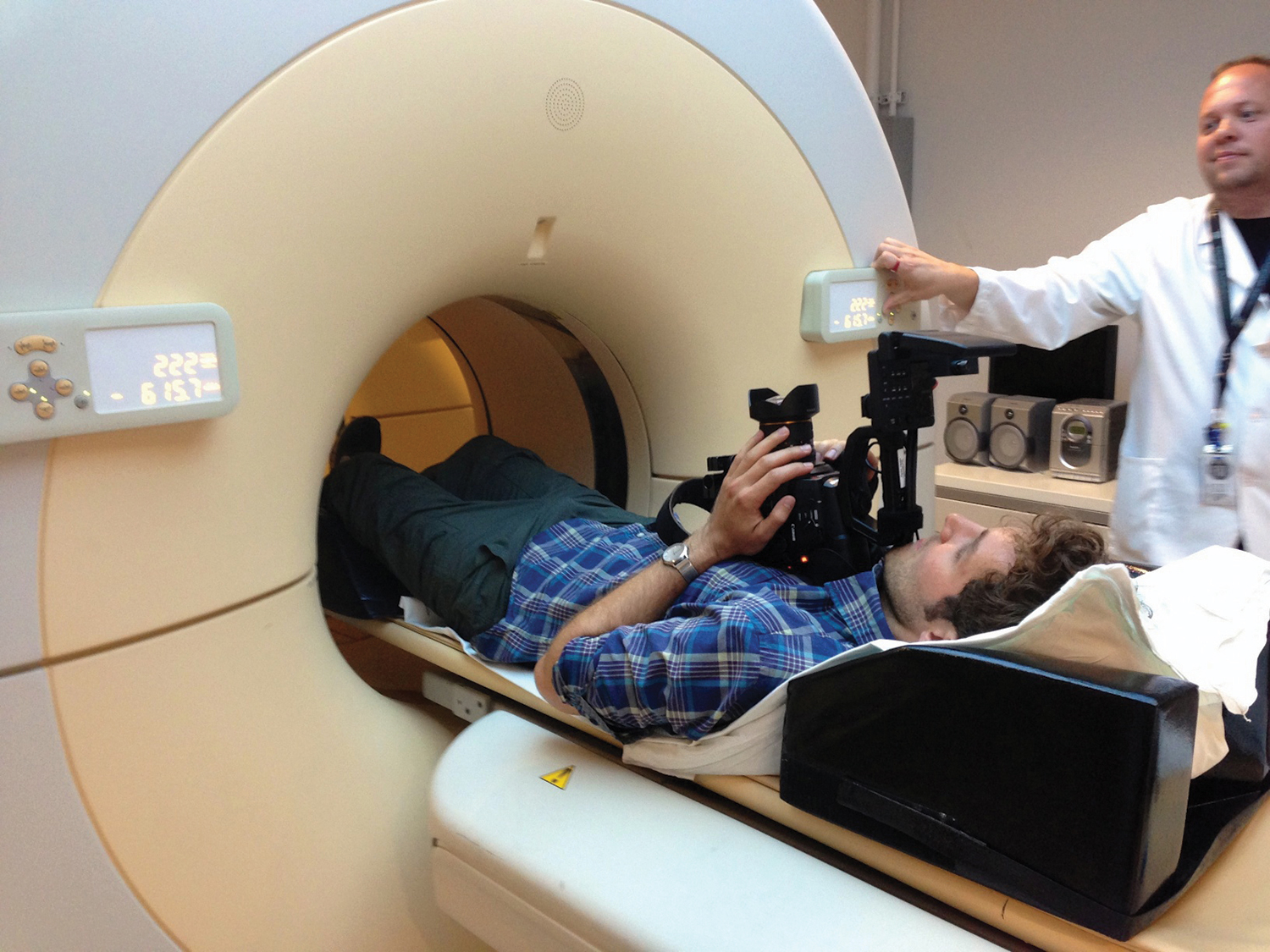
The Emperor of All Maladies was shot in a number of locations. Ryan Haske takes a camera into an MRI machine at Charleston Area Medical Center in West Virginia. Photo by Lindsey Megrue
As writers Goodman, Burns, Geoffrey Ward, Burns’ scriptwriter, and David Blistein, an author and longtime friend of Burns, developed the “present” segment, they decided to feature two institutions—the Johns Hopkins Kimmel Cancer Center in Baltimore and the Charleston Area Medical Center (CAMC) in Charleston, West Virginia. Kimmel is one of only 68 National Cancer Institute-designated cancer centers nationwide, while CAMC is a regional health system.
“We wanted a research hospital where we could see what is the most cutting-edge kind of treatment and clinical trials, where people go when they have very few other options [for effective treatment], and we also wanted a more standard-of-care kind of place,” says Goodman. To get the flavor of each institution, a film team immersed itself in each hospital’s culture for more than a year, getting to know patients, families and staff members.
At Johns Hopkins, the film crew was embedded in the pediatric oncology ward and witnessed many poignant moments, including the death of a child. Ali Sargent, the producer at Johns Hopkins, remembers that “we were able to see that the whole [health care] team and the parents were an extended family of sorts on the pediatric oncology floor.”
At CAMC, the film crew focused on oncologists who treat all kinds of cancer. “It might be breast cancer, followed by lung cancer, followed by leukemia. They really see it all,” says Lindsey Megrue, the producer at CAMC.
Caitlin Waters shares her experiences with cancer and in being interviewed for the film.
Caitlin Waters, who was filmed in 2013 for Cancer: The Emperor of All Maladies, began experiencing unusual symptoms in January 2012, during her sophomore year at the University of Texas in Austin. “I was having a lot of weird body temperature things,” recalls Waters, who is from Falls Church, Virginia. “I would wake up in the middle of the night in a puddle of sweat, and I couldn’t figure it out. I was running short of breath on the way to class that is just a short walk away. I had always been athletic, so that was pretty strange, too.”
Waters went to a University Health Services clinic, where blood tests revealed the likelihood that she had leukemia. Doctors told her to go to the emergency room at St. David’s Medical Center in Austin. Further testing revealed that she had acute myeloid leukemia (AML).
Waters and her parents decided it would be best if her treatment took place closer to their Virginia home, so a few days after her diagnosis, she was admitted to the Johns Hopkins Kimmel Cancer Center in Baltimore. Over a period of two months, she was given a combination of the drugs Idamycin (idarubicin), cytarabine and etoposide, a regimen used to treat AML.
By fall 2012, Waters was in remission and back in college for her junior year. But in March 2013, while studying abroad in Barcelona, Spain, a blood test showed her leukemia had come back. She returned home, and doctors at Johns Hopkins determined she needed a bone marrow transplant. Fortunately, her father was a match and could be her donor. Before the transplant, she had two rounds of chemo—one similar to the treatment she had received before and the second a high-dose regimen to knock out any remaining cancer cells. The transplant took place on June 11, 2013.
While she was recovering at Johns Hopkins in July 2013, the film team for Cancer: The Emperor of All Maladies arrived on Waters’ floor. After a few preliminary interviews, they asked her to participate in the project. She readily agreed, largely because she wanted to help raise awareness about cancer and to stress the importance of going to the doctor when you don’t feel well.
Over a period of several months, Waters was filmed talking with her doctors, hanging out with the nurses, doing walking laps in the hallway to show she was feeling better, and lying in bed when she wasn’t feeling well. Also captured on film was a budding friendship with David Hatfield, a 54-year-old stage IV lymphoma patient, who met Waters while she did her laps. When Hatfield found out Waters attended the University of Texas—where his partner, Sid Stolz, had received his business degree—the three became friends, bonding over their shared experience with cancer and their love of the University of Texas and Longhorns football.
Waters, now 23, had hoped to put cancer behind her, but in November 2014, she found out her cancer had returned yet again. As of December 2014, doctors at Johns Hopkins were trying to determine if she qualified for a clinical trial testing a new treatment, based on whether she has a genetic mutation that occurs in about one in three AML patients.
“At this point, it’s more of an annoyance than something I get really upset about, considering it’s my third time,” she says. “I’m ready to start treatment as soon as possible and get it over with as soon as possible and get on with my life.”
Now a senior, Waters plans to attend graduate school. She notes that cancer has made her more impatient, “eager to do everything that I’ve ever put off right now. I think it’s kind of made me more adventurous and spontaneous, just kind of realizing that things can happen you’re not prepared for.”
Where We Are Going
“When you talk to people in the field,” says Chris Durrance, the producer of the film’s third segment on current research and the prospect for cures, “it seems that we are just at the dawn of an immensely exciting era for cancer.”
One of the most promising recent developments is the field of immunotherapy, in which treatments use the body’s own immune system to fight cancer. Precision medicine, tailoring treatments to target a tumor’s cancer-causing genetic mutations, is another discovery at the forefront of innovations.
Major breakthroughs have been heralded in the past, however, with reality often failing to live up to expectations. This time is different, Mukherjee says, because the science underpinning new therapies has never been better understood. “Things are changing so fast, especially for some kinds of cancer,” he says.
And the field is still unpredictable, with progress occurring where it might not have been expected. Mukherjee himself is surprised by the direction taken by some new breakthroughs. For example, he would have expected lymphoma and leukemia to benefit first from immunotherapy. “Yet the surprise is that the lead was taken by solid tumors such as melanoma,” he says. “I could give you answers [about future breakthroughs], but that would be wrong, and it’s a wonderful thing to be wrong. These corners are turned so rapidly and that’s what makes it exciting.”
Cancer Today magazine is free to cancer patients, survivors and caregivers who live in the U.S. Subscribe here to receive four issues per year.

